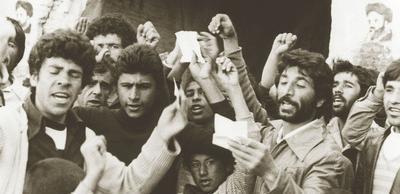
Days of Unrest: Political Unrest in an Iranian Village

Days of Revolution: Political Unrest in an Iranian Village. Mary Elaine Hegland. Stanford: Stanford University Press, 2013. xxxv + 316 pp.
First published: 14 August 2015
When Mary Elaine Hegland flew to Iran in 1978 with her family to conduct fieldwork on agricultural credit systems, she had no idea that she would soon be researching a revolution in the making. Demonstrations against the Shah began that year, first in Iran's urban centers and then in the countryside, leading to the 1979 Revolution and, eventually, the creation of the Islamic Republic. Despite the political unrest, Hegland was able to continue conducting ethnographic research, albeit with great difficulty. The result is her much-awaited book, Days of Revolution, which is the culmination of more than 18 months of fieldwork in “Aliabad,” a then- small village outside of Shiraz, as well as more recent research some 34 years later. A rare and intimate account of village life before, during, and after the 1979 Islamic Revolution, Days of Revolution challenges some of the most frequently publicized assumptions concerning the Revolution; it provides new insight into the ways in which local politics and models, for and of action, can inform national events and reveals the tremendous value of longue durée ethnographic research.
Until recently, the prevailing view was that the 1979 Revolution was a religious backlash against the superficial, rapid, and spiritually vacant modernization policies of Mohammad Reza Shah Pahlavi. A revitalized Shi'i religious establishment, led by the Ayatollah Khomeini and other religious scholars, won the day. Through oral history, participant-observation, and first-person narratives of key events in Aliabad, Hegland shows that several other factors were equally, if not more, important to Aliabadis’ ultimate participation in political protest against the Shah's government. The most obvious of these, according to Hegland, were the pragmatic effects of the Shah's modernization program, including increased literacy and new infrastructure for travel and communication, which allowed people to move from place to place, demonstrate, and march. These changes further resulted in a decreased dependence on agricultural land and an increase in jobs in factories and neighboring cities, thereby freeing people from the control of the community representatives of the Shah's government. Others factors—here resonating with the general sentiment of villagers at my own nearby field site in 2010—included the increased inequity and unevenness of the Shah's modernization and the accompanying brutal repression of local political change by powerful and wealthy officials and their gendarmes. Finally, and most fundamentally, Hegland argues that participation in the Revolution, at least at the village level, was spurred not by Shi'a ideology as such but, rather, by a series of local events, including a stone-throwing incident led by a powerful supporter of the Shah and the stabbing of the son of a martyred village hero. These events ultimately motivated Aliabadis to shift their views and actions in favor of the Revolutionary movement by prompting a surge of sentiment against the Shah (and his local supporters) and for the Revolution. This shift and realignment of support, Hegland further contends, were largely guided by a key political paradigm through which villagers engaged one another, that of taifeh-keshi, a form of competition between permeable coalitions of kin, political associates, dependents, wives, children, poor relatives, and workers headed by male leaders, the bigger the stronger.
Indeed, the significance of taifeh-keshi relationships as a reason for side-taking and national political participation is a key theme of Days of Revolution. Reproduced through practices of telling stories about past conflicts, sharing hospitality, staging performances, rituals, and through everyday conversation, taifeh-keshi had been the main framework by which powerful leaders such as village headmen were selected and institutionalized before land reform (although its use had never entirely faded out, especially by women who arranged their own social affiliations and support networks). During the chaos of the Revolution, Hegland argues, taifeh-keshi, as a process of showing and forming political alliance, was reinvigorated, guiding villagers’ decision making and side taking. It not only served to influence people's interpretations of national events but also to channel their behavior. Via taifeh-keshi they began to participate in what were often dangerous protests supporting the Ayatollah Khomeini. Local politics were linked to national protest and support of the Revolution.
Days of Revolution begins with “Historical Aliabad,” a chapter that spans from 1870 to 1963 and provides readers with a sense of the social organization of Aliabad when it was owned by the Qavams, a family of absentee landlords. It continues with clear analysis of what Hegland calls the “Mossadeq Era” and its political suppression before moving to an intimate illustration of the inequity of land rights in the 1963 land reform. The penultimate section details the buildup to the 1979 Revolution and its aftermath and includes provocative, first-person narratives of protest and other involvement in the Revolution by both women and men. The final chapter provides a stunning portrait of the dramatic changes in Aliabad life as recently as 2013, giving readers a coherent case study of how Iranian provincial towns have changed over time.
Days of Revolution is rich with ethnographic detail and written in accessible language, making it useful not only to students of anthropology, Iran, and the Middle East but also to those interested in the ways in which ethnographic research methods intersect with social movements and political science. Hegland provides a timely and complex example of the interplay between local and national politics in Iran. She also gives the reader a taste, not only of what the study of political science, social movements, and the like can gain from ethnography but also of what ethnography can gain from long-term fieldwork. Finally, the best feature of the book is its extensive inclusion of diverse interlocutors’ interpretations of events, stories, and life histories. In sum, as a kind of microlevel ethnographic history of a region and its politics, Days of Revolution is a must-read for anyone interested in Iran.